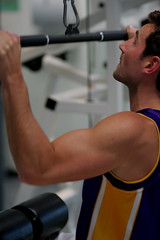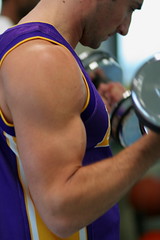Resistance bands are a very popular tool in fitness- they are a very versatile product. The resistance bands have their appeal because they travel easy, store anywhere, and are very inexpensive. Now consider the health benefit, they increase coordination, add variety to your workout- and perhaps best of all, they increase flexibility. Good flexibility is important, especially to body builders. It keeps you from experiencing as much pain and tightness during a workout, allows you to utilize more muscle groups at once, and prevents injuries. So, how do you use resistance bands to boost your flexibility?
—-
How to Boost Your Flexibility with Resistance Bands
Resistance bands are one piece of equipment every gym should have. I’ve been recommending resistance bands from Iron Woody for some time. Here are some ways you can use them:
• Mobility & Activation Exercises. Shoulder dislocations, x-band walks, band pull-aparts, band tractions, … You can do all of them using a mini or light band.
• Pull-ups & Chin-ups. If you can’t do a single rep, use a resistance band to assist you on the way up. Loop the band around your pull-up bar and your knee. The band will help you from the bottom up. This is one of the easiest ways to get stronger at Pull-ups & Chin-ups. Video.
• Push-ups. Wrap a resistance band across your back while holding it in your hands. Now push yourself up. The stronger the band, the harder push-ups become. This is an easier way to make Push-ups harder than wearing chains, a rucksack or Xvest. Watch the video.
• Pulley Exercises. My home gym has no pulley system. So I use a mini band for exercises like Face Pulls. You can do most pulley exercises with bands: lat pulldowns, seated leg curls, seated rows, push downs, …
Where to Get Resistance Bands? The 2 big companies selling resistance bands are Iron Woody & Jump Stretch Inc. I have bands from both companies. I prefer the Iron Woody’s because they’re stronger & cheaper.
Which Resistance Bands Should You Get? Get a set of mini and light bands. If you’re a big guy doing assisted Pull-ups: use the 2 bands combined to get the same assistance as heavier bands at the same cost.
When you get stronger: use the light band only. Then the mini only. If you start with stronger bands, you’ll have to go to nothing or buy extra bands. Stick with mini & light bands and make sure you get the 41″ bands, not the short ones.
Incorporating resistance bands into your fitness routine is defiantly a smart move. They can be put in any suitcase, gym bag, and even fit into most purses- they add variety, and are very inexpensive. When Resistance bands provide a way to train with tension and they are available at almost every retail store.
So, you’ve decided to start using the resistance bands to increase flexibility, how do you choose? There’s a few simple things to keep in mind when you pick out your new bands. Start off by buying a variety of bands, most come in colors that represent a certain level of tension- think light, medium, heavy, and very heavy. Having at least three different tensions is the best to begin with since different muscle groups have different requirements. Make sure you are also shopping for comfortable and easy to use bands so you won’t lose the motivation to use them after an awkward workout- many have interchangeable handles, grips, and cushions. This is a simple product, so just be sure to keep it simple when you are shopping for them.
The bands can be used for mobility and activation exercises such as shoulder dislocation, x-band walks, band pull-aparts, and band retractions. You can also use them for pull-ups, chin-ups, and push-ups. Users can even use them to do pulley exercises like lat pulldowns, seated leg curls, seated rows, and push downs.
Watch this video for some more basic moves…
Are you ready to start increasing your flexibility with resistance bands?




 that recorded in my book , the next week it says 140 then 145 not much later and so forth. Now 6 months later I can do 220lbs on lat pull downs for four sets of 12(Just did that a few days ago) and talk to me a few weeks from now and hopefully ill be up to 225 or 230. Now you may have noted I like pullups far more then lat pull downs as a core mass builder, but when I switched to lat pull downs and simply progressed this way my pull-up ability also shot up. Just as slowly progressing on EZ bar preacher curls will help your standing barbell curl, incline dumbbell curl, and hammer curl strength all rise. In addition, do not forget to keep the tape measure handy because I guarantee if you progress on both tricep and bicep work consistently your upper arm size will progress as well.
that recorded in my book , the next week it says 140 then 145 not much later and so forth. Now 6 months later I can do 220lbs on lat pull downs for four sets of 12(Just did that a few days ago) and talk to me a few weeks from now and hopefully ill be up to 225 or 230. Now you may have noted I like pullups far more then lat pull downs as a core mass builder, but when I switched to lat pull downs and simply progressed this way my pull-up ability also shot up. Just as slowly progressing on EZ bar preacher curls will help your standing barbell curl, incline dumbbell curl, and hammer curl strength all rise. In addition, do not forget to keep the tape measure handy because I guarantee if you progress on both tricep and bicep work consistently your upper arm size will progress as well. One of the most underrated aspects of
One of the most underrated aspects of 